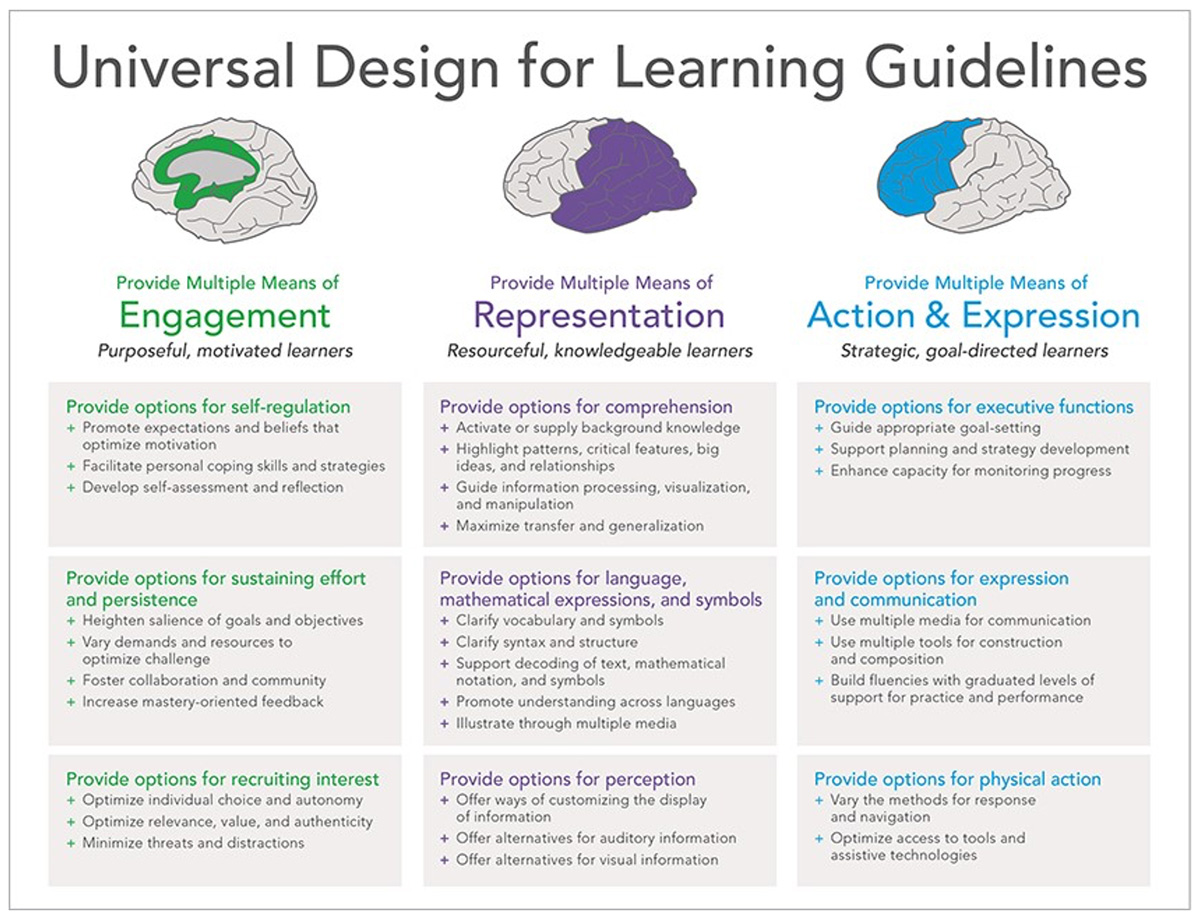Universal Design
What is Universal Design for Learning and Universal Design of Assessment?
Universal Design for Learning (UDL) is a set of principles for curriculum and assessment development that provides all students with equal opportunities to learn. “UDL provides a blueprint for creating instructional goals, methods, materials, and assessments that work for everyone – not a single, one-size-fits-all solution but rather flexible approaches that can be customized and adjusted for individual needs” (National Center on Universal Design for Learning, 2012).
UDL’s three principles are based on neuroscience research, which has identified three primary neurological networks that impact learning: 1) Engagement, 2) Representation, and 3) Action and Expression. These principles guide design of learning environments with a deep understanding and appreciation for individual variability by considering how students’ abilities can influence the representation of content, response to content, and engagement during learning.
The UDL Guidelines (Meyer et al., 2014) provide checkpoints that guide educators in the development and implementation of UDL curricula and assessments. These Guidelines (see Exhibit 1) serve as a tool with which to critique and minimize barriers inherent in curricula and assessments as educators aim to increase opportunities to learn.
Exhibit 1. Universal Design for Learning Guidelines

Universal Design of Assessment (UDA) is based on the same concepts as UDL with a goal to increase access for the widest range of students possible and to accurately understand what students know and can do. The National Center on Educational Outcomes (NCEO, 2016) propose seven elements to increase assessment validity and accessibility:
1. Inclusive assessment population
2. Precisely defined constructs
3. Accessible, non-biased items
4. Amendable to accommodations
5. Simple, clear, and intuitive instructions and procedures
6. Maximum readability and comprehensibility
7. Maximum legibility
Applying the principles found in the UDL Guidelines for assessments assists developers in addressing each of these seven elements.
Why consider the principles of Universal Design to develop assessments?
Accessibility is a key element in every phase of assessment system development and implementation. Central to the goals of an innovative assessment system is understanding how the provision of meaningful, research-based accessibility strategies and accommodations result in the accurate demonstration of broad representations of knowledge, and thus support valid inferences for all students.
According to AERA/APA/NCME (2014, pp. 6-7), tests should be designed to facilitate and minimize construct-irrelevant barriers for all test takers in the target population. UDL seeks to make educational materials and assessments as accessible as possible to the widest variety of students while seeking to minimize separate-but-equal situations.
UDL provides flexibility in the ways information is presented, in the ways students respond or demonstrate knowledge and skills, and in the ways students are engaged (Higher Education Act, 2008). Applying the principles of UDL to assessment development provides guidance in creating assessment materials that reduce barriers, optimize levels of challenge, and minimize the need for additional accommodations for students, including students with disabilities and students who are limited English proficient, while maintaining high achievement expectations for all students. In addition to assisting teachers in planning lessons/units of study, utilizing the UDL Guidelines also helps them create or select classroom assessments that are accessible and that appropriately demonstrate student learning. Embedding the principles of UDL in the development and implementation of assessments addresses an important component of an inclusive system of assessments. As stated by Thurlow, Lazarus, Christensen, & Shyyan (2016, p. 7), “Accessible assessments are used to allow all students to show their knowledge and skills on the same challenging content.”
How does one use the principles of Universal Design to develop assessments?
Understanding the characteristics of the students taking the assessment is one of the first steps in the application of UDL principles to inform the design of each item and to minimize the need for adaptations and accommodations for students to access the measured construct. Through the application of a principled-design approach to assessment development, UDL principles should be carefully incorporated into the assessment item design including operational items, field test items, and test bank items. The UDL approach focuses the development of items for all students on construct-relevant content (the knowledge, skills, and abilities intended to be measured), minimizing the impact of construct-irrelevant skills (e.g., print size, lack of assistive technology device, inability to engage with the items) and considering appropriate accessibility options.
By incorporating the guidelines of UDL as described via the National Center on Universal Design for Learning (http://www.udlcenter.org/), the SCILLSS partners will consider how students’ abilities and characteristics can influence the representation of content, response to content, and engagement during learning and address multiple means of representation (the “what” of learning), expression (the “how” of learning), and engagement (the “why” of learning) in the development of performance tasks/items (Rose & Meyer, 2006; CAST, 2011).
UDL resources are available at the National Center on Universal Design for Learning’s Resource Library.
References
American Educational Research Association, American Psychological Association, & National Council on Measurement in Education (AERA/APA/NCME). (2014). Standards for educational and psychological testing. Washington, DC.
CAST. (2011). Universal design for learning guidelines version 2.0. Wakefield, MA: Author.
Higher Education Act of 1965, 20 U.S.C. §§ 1001–1161aa-1 (2008).
Meyer, A., Rose, D.H., & Gordon, D. (2014). Universal design for learning: Theory and Practice. Wakefield, MA: CAST Professional Publishing.
National Center on Educational Outcomes. (2016). Universal Design of Assessments. Retrieved on October 18, 2017 from https://nceo.info/Assessments/universal_design
National Center on Universal Design for Learning. (2012). What is UDL? Retrieved on October 18, 2017 from http://www.udlcenter.org/aboutudl/whatisudl.
Rose, D. H., & Meyer, A. (2006). A practical reader in universal design for learning. Cambridge, MA: Harvard Education Press.
Thurlow, M. L., Lazarus, S. S., Christensen, L. L., & Shyyan, V. (2016). Principles and characteristics of inclusive assessment systems in a changing assessment landscape (NCEO Report 400). Minneapolis, MN: University of Minnesota, National Center on Educational Outcomes. https://nceo.umn.edu/docs/OnlinePubs/Report400/NCEOReport400.pdf
